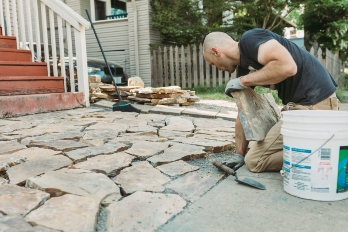Trying to map out your future? We don’t have a crystal ball or Ouija board, but we can tell you that homeownership can be the cornerstone of a life plan that puts you where you want to be, when you want to be there.
> > > Insert your vision of a great life here. Ahh, the satisfaction.
That kind of success depends a lot on goal-setting and money management. Yeah, all that stuff that parents and financial planners have been telling us about for years.
So we’ve got some inspiration for you: Katie and Alex, a couple of savvy 30-something homeowners who’ve been doing all the adulting stuff — and reaping pretty exciting benefits. In the savvy department, it helps that Katie’s work has always involved real estate. Today, she’s VP of lending and investment at the Housing Partnership Network (one of Framework’s nonprofit owners).
We first shared Katie and Alex’s story back in 2014. They’d bought a little condo in the Boston area despite being loaded down with more than $80,000 in student loan debt. Their plan was to pay down debt like mad while building equity, then trade up just in time to start a family.
And…
Three years later, Katie tells us they’re settling into a four-bedroom house in a great suburb, have nearly put their student debt behind them, and just welcomed their second child. Ahh.
Here are five smart moves from Katie and Alex that we could all benefit from following.
Smart move #1: Build equity now with a starter home
When we last talked, Katie told us that when she and Alex bought their condo in 2009, they already had more than $80,000 in student loan debt and would later pile on more to pay for Katie’s MBA. But they were determined to start building equity, so they scaled back their expectations and took their “low budget” (in the Boston area, that means under $300,000) to the city’s Jamaica Plain neighborhood, where they bought a two-bedroom condo with street parking. “This was always meant to be a five- to seven-year home,” Katie said at the time.
Their decision was already paying off, thanks in part to good timing. With Boston-area home prices and rents rising rapidly, they were paying $400 or $500 less for their mortgage than they would have been spending in rent. Which helped them keep chipping away at that student loan debt.
Smart move #2: Make saving your norm
A lot of us think about saving … but then that hot new $$$ restaurant or trip to Barcelona beckons. With an eye to their future, Katie and Alex actually do it, almost automatically.
When they bought the condo, they were still in their twenties and had just married, Katie says. “We’d been saving for our wedding pretty aggressively, and then we just kind of switched to saving for the house. And then, with buying a home early, we didn’t really know what it was like not to have that responsibility. We’ve just always coexisted with a mortgage.”
“As our income went up, into our thirties,” she says, “we were already used to kind of always saving for the next thing. We never really thought, Oh, we’re going to go on fifteen elaborate vacations this year because we can.”
Smart move #3: Refinance when the math works
Refinancing for a lower interest rate can save you tens of thousands of dollars over the life of your mortgage, so paying attention to what rates are doing is an important part of managing the investment that is your home. Katie and Alex refinanced their condo at a lower interest rate twice in the space of six years.
The first time, in 2013, was a no-brainer. They had an FHA mortgage with mortgage insurance premium (MIP), Katie says. Thanks to the equity they were building, they got into a conventional mortgage that both lowered their interest rate and got rid of their mortgage insurance.
The second time, less than two years later, took some extra thought. Although interest rates had dropped even more, they knew they wanted to sell the condo relatively soon: their first child, Charlie, was entering toddler territory, and they were planning for a second. Was the cost of refinancing still worth it?
They found a deal with no closing costs, so the math worked. “I feel like the mortgage brokers were really hungry to refinance,” Katie recalls. “It was winter, and they weren’t doing a lot of mortgage originations. I looked closely at it, but there really weren’t any hidden fees.”
Smart move #4: Reinvest that equity
As luck would have it, the Jamaica Plain market didn’t just keep rising, it exploded. “We got way more equity in the condo than we ever thought we would,” Katie says.
The “JP” market is so hot, the couple seriously considered keeping the condo and renting it out, she says. But besides hesitating to become landlords, she says, “I realized that we could buy the house we really wanted by selling. I also realized that we could pay down a good chunk of my grad school debt, which is the debt that has a higher interest rate. And that gave us more money to pay the higher mortgage we would have with a bigger house.”
Plus, they had their eye on another competitive, high-growth market, Melrose. It’s a walkable, family-friendly suburb north of Boston with good access to public transportation for commuting into the city. “There was a house we bid on that got 21 offers,” Katie says. “So we felt like we needed all the money we could get to move to the town we wanted to move to.”
They ended up in a 100-year-old, four-bedroom Colonial with plenty of sunny play space. “One thing we didn’t get was a garage,” Katie says. “That’s on the wish list if we ever get another house. We were just excited to have a driveway.”
Smart move #5: Learn the financial rhythm of your house
Almost every new homeowner is going to have a period of adjusting to all the new expenses. Although Katie and Alex are on their second home, it was a big jump financially, especially when they were about to add to their childcare costs.
“It’s been a little scarier,” Katie says. “We’ve more than doubled our mortgage. It’s in line with what we make, but still. And all of a sudden, we have water and sewer bills — that always got paid out of the condo association. It’s more than I thought it would be. Air-conditioning costs more. And the property taxes are higher here.”
So, one year in, they’re still “learning the financial rhythm of the house,” she says. “I am still just kind of nervous. It’s like, wow, we have this whole house, and if something happens we’re in charge of fixing it on our own versus the condo association.”
For the moment, she’s slowed down on paying off what’s left of her student loans (Alex’s are paid off). Nevertheless, the balance should be gone in two years max. “Because I’m kind of towards the end anyway, a lot of it is going towards principal, so I don’t feel as bad.”
At some point, they’ll start saving for a kitchen facelift. The teal countertops and fruit-cornucopia backsplash were the main style flaws that caught her eye when they looked at the house. It’s not as bad as it sounds, she claims. “I’ve kind of grown to like it in this weird way.”
Ready to take the next step in your homebuying journey with all the confidence of a smart and savvy homebuyer? Our comprehensive online homebuyer education course is simple and easy to access on your computer, tablet, and mobile device. It’s all the information you need, all in one place. Go ahead and get started today.




